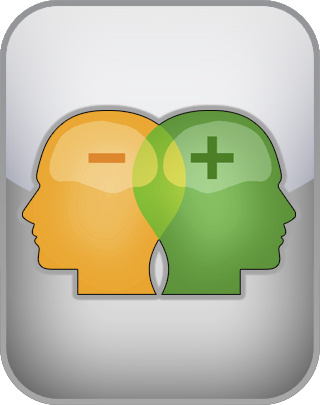Academically reviewed by Dr. Sabina Alispahić, Ph.D., professor of psychology
Bipolar II Test
Bipolar II disorder is a subtype of bipolar disorder, a mental health condition characterized by fluctuations between depressive and hypomanic episodes. In contrast to bipolar I disorder, individuals with bipolar II experience depressive episodes but have hypomanic periods rather than full-blown manic episodes.
Are you showing signs of bipolar II disorder? For each of the following questions, indicate how well it applies to you.
Question 1 of 32
For at least a week, I have experienced the following…
Others felt unable to keep up with my inspiration in conversations.
| Disagree | Agree |
NEXT
The IDRlabs Bipolar II Test was based on the Diagnostic and Statistical Manual for Mental Disorders, 5th edition and developed by IDRlabs.
Bipolar II disorder is a mental health condition characterized by recurrent episodes of depression and hypomania. Major depression is characterized by persistent feelings of sadness, hopelessness, and low energy. These depressive episodes can be severe and impact daily functioning. Unlike bipolar I disorder, individuals with bipolar II experience hypomanic episodes rather than full manic episodes. Hypomania involves a milder form of elevated mood, increased energy, and impulsivity. While hypomania can be disruptive, it is generally less severe than mania.
The exact cause of bipolar II disorder is not fully understood, and it likely involves a complex interplay of genetic, biological, and environmental factors. There is evidence suggesting a hereditary component, as individuals with a family history of bipolar disorder may be at a higher risk. Imbalances in neurotransmitters, particularly serotonin and norepinephrine, are thought to contribute to the mood dysregulation seen in both depressive and hypomanic episodes. Stressful life events, trauma, and significant life changes may also play a role in triggering episodes. Additionally, structural and functional brain abnormalities have been observed in individuals with bipolar disorder, although the precise relationship between these abnormalities and the development of the disorder is still being researched. Bipolar II disorder is likely a result of a combination of genetic vulnerabilities and environmental influences, and ongoing research aims to deepen our understanding of its underlying causes.
People with bipolar II disorder cycle between depressive and hypomanic episodes. The mood swings can vary in frequency, with periods of normal mood in between episodes. Due to the less pronounced nature of hypomania, individuals with bipolar II may be misdiagnosed with major depressive disorder. Recognition of hypomanic symptoms is essential for an accurate diagnosis.
There is a genetic predisposition to bipolar II disorder, with a higher risk among individuals with a family history of bipolar disorder. Imbalances in neurotransmitters, such as serotonin and norepinephrine, are implicated in the mood dysregulation seen in both depressive and hypomanic episodes. Stressful life events, trauma, and significant life changes can contribute to the onset of mood episodes in individuals with bipolar II disorder.
Bipolar II disorder can lead to impaired functioning in various areas of life during mood episodes. Individuals may struggle with work, relationships, and daily responsibilities. Treatment typically involves a combination of mood stabilizers, antidepressants, and psychotherapy. The goal is to stabilize mood, manage symptoms, and improve overall functioning. Bipolar II disorder is a chronic condition that often requires ongoing management. With effective treatment, individuals can lead fulfilling lives, but long-term care and support are crucial.
It's important to note that while these facts provide an overview of bipolar II disorder, individual experiences may vary. Seeking professional help for an accurate diagnosis and appropriate treatment is crucial for individuals experiencing symptoms of bipolar II disorder.
The treatment for bipolar II disorder typically involves a multifaceted approach that combines medication, psychotherapy, and lifestyle adjustments. Mood stabilizers like lithium, lamotrigine, and valproate are commonly prescribed to stabilize mood and prevent both depressive and hypomanic episodes. Antidepressants may be used cautiously during depressive episodes, and antipsychotic medications, such as quetiapine, can help manage mood symptoms. Psychotherapy, particularly cognitive-behavioral therapy (CBT) and psychoeducation, plays a crucial role in helping individuals understand and manage their symptoms, addressing issues related to mood regulation, stress management, and interpersonal relationships.
Regular monitoring by healthcare providers is essential to assess medication effectiveness, adjust dosages, and address emerging symptoms or side effects. Lifestyle adjustments, including maintaining a healthy routine, regular exercise, a balanced diet, and stress reduction techniques, contribute to overall well-being. In severe cases or when other treatments prove ineffective, electroconvulsive therapy (ECT) may be considered. Collaborative and ongoing care, tailored to individual needs, is crucial for effectively managing bipolar II disorder and promoting stability in mood and daily functioning.
As the publishers of this free test, which allows you to screen yourself for the characteristics of bipolar II disorder, we have strived to make the test as reliable and valid as possible by subjecting this test to statistical controls and validation. However, free online quizzes such as the present test do not provide professional assessments or recommendations of any kind; the test is provided entirely “as-is.” For more information about any of our online tests and quizzes, please consult our Terms of Service.

